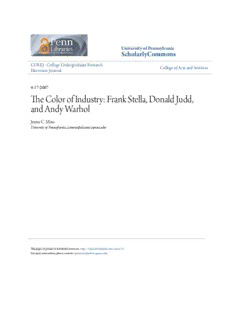
The Color of Industry: Frank Stella, Donald Judd, and Andy Warhol PDF
Preview The Color of Industry: Frank Stella, Donald Judd, and Andy Warhol
UUnniivveerrssiittyy ooff PPeennnnssyyllvvaanniiaa SScchhoollaarrllyyCCoommmmoonnss CUREJ - College Undergraduate Research College of Arts and Sciences Electronic Journal 4-17-2007 TThhee CCoolloorr ooff IInndduussttrryy:: FFrraannkk SStteellllaa,, DDoonnaalldd JJuudddd,, aanndd AAnnddyy WWaarrhhooll Jenna C. Moss University of Pennsylvania, [email protected] Follow this and additional works at: https://repository.upenn.edu/curej Part of the American Art and Architecture Commons RReeccoommmmeennddeedd CCiittaattiioonn Moss, Jenna C., "The Color of Industry: Frank Stella, Donald Judd, and Andy Warhol" 17 April 2007. CUREJ: College Undergraduate Research Electronic Journal, University of Pennsylvania, https://repository.upenn.edu/curej/51. This paper is posted at ScholarlyCommons. https://repository.upenn.edu/curej/51 For more information, please contact [email protected]. TThhee CCoolloorr ooff IInndduussttrryy:: FFrraannkk SStteellllaa,, DDoonnaalldd JJuudddd,, aanndd AAnnddyy WWaarrhhooll KKeeyywwoorrddss Abstract Expressionism, Minimalism, Pop Art, Humanities, Art History, History of Art, Christine Poggi, Poggik, Christine DDiisscciipplliinneess American Art and Architecture This article is available at ScholarlyCommons: https://repository.upenn.edu/curej/51 I The Color of Industry: Frank Stella, Donald Judd, and Andy Warhol Jenna C. Moss 20 March 2007 Advisor: Dr. Christine Poggi SubmittedinPartial Fulfillment OftheRequirements for theDegreeof BachelorofArts WithDistinctionintheMajorSubject Department oftheHistoryof Art UniversityofPennsylvania II I TABLEOFCONTENTS LISTOF ILLUSTRATIONS ................................... II Chapter 1. INTRODUCTION .... .................................... 1 2. FRANKSTELLA: THE METALLIC GALLERY ............... 10 3. DONALDJUDD: THE INDUSTRIALENVIRONMENT ........ 27 4. ANDYWARHOL: THE SILVER OBSESSION . ............... 44 5. CONCLUSION ....... ................................... 59 FIGURES ........... ....................................... 67 SELECTED BIBLIOGRAPHY ................................. 81 II LISTOF ILLUSTRATIONS Figure 1. Barnett Newman,Vir Heroicus Sublimus,1950-1951,Oil oncanvas,The Museum ofModernArt, NewYork, www.moma.org. 2. Robert Rauschenberg, ErasedDeKooningDrawing,1953,drawing,traces of ink and crayon on paper, mat, label, and gilded frame, San FranciscoMuseum ofModernArt,www.sfmoma.org. 3. JacksonPollock,Lavender Mist,1950,Oil,enamel,andaluminum paint, National GalleryofArt, www.nga/gov. 4. FrankStella,Die FahneHoch!,1959,Blackenamel oncanvas,Whitney Museum ofAmericanArt,FisherFineArts Image Collection. 5. FrankStella, Installation photographofAluminumPaintings,1960, aluminum paint oncanvas, LeoCastelli Gallery,FisherFineArts ImageCollection. 6. FrankStella,Six Mile Bottom,1960,aluminumpaint oncanvas,Tate Gallery, London,www.tate.org/uk. 7. FrankStella,Jill,1959,metallicburglar-alarm tape,Collectionof LawrenceRubin,Jones,MachineintheStudio,157. 8. FrankStella,Marquis dePortago(secondversion),1960,aluminum paint oncanvas,Private Collection,NewYork,in Rubin,FrankStella Paintings: 1958-1965,108. 9. DonaldJudd, Installationphotographof“New Work: Part 1”, 1963, various mediums,Green Gallery,NewYork,inMeyer,Minimalism: Art andPolemics intheSixties,46. III 10. DonaldJudd,Untitled,1965,galvanizediron,seven parts,Moderna Museet,Stockholm,inKellein,DonaldJudd: 1955-1965,128. 11. DonaldJudd, Installationphotographof“La MansanadeChinati”,1964- 68,TheChinati Foundation,Marfa,Texas,inKellein,DonaldJudd: 1955-1965,136-37. 12. DonaldJudd,Untitled,1969,clear anodizedaluminum andpurple Plexiglas,PrivateCollection,Switzerland,inElger,DonaldJudd: Colorist,41. 13. DavidSmith,Cubi XXVII,1965,stainless steel,SolomonR.Guggenheim Museum,NewYork, www.guggenheimcollection.com. 14. DonaldJudd,Permanent installation offifty-twoworks,photograph from 2004,anodizedaluminum, Northartilleryshed,TheChinati Foundation,Marfa,Texas,inSerota,DonaldJudd,130. 15. DonaldJudd,Permanent installationofforty-eight works, photograph from 2004,brass,Southartilleryshed,TheChinati Foundation,Marfa, Texas,inSerota,DonaldJudd,131. 16. Andy Warhol intheSilver Factory,photographbyJonNaar,1965, Reynolds aluminum foil and DuPont Krylonindustrial paint,New York,FisherFine Arts ImageCollection. 17. AndyWarhol,Silver Clouds,1966,Helium-filledScotchpak,The Warhol,Pittsburgh,Photographbytheauthor. 18. Photograph at theopeningof “AndyWarhol,” 1965, Instituteof ContemporaryArt,Philadelphia,Fisher FineArts Imagecollection. 19. AndyWarhol,Brillo,1964,syntheticpolymer paint andsilkscreenon wood,TateGallery, London,Fisher FineArts Collection. IV 20. AndyWarhol,Triple Silver Disaster,1963,silverpaint andsilkscreenon linen,WadsworthAthenaeum,FisherFine Arts Collection. 21. AndyWarhol,Silver MarlonBrando,1963,acrylicsilkscreenoncanvas, PrivateCollection,FisherFineArts ImageCollection. 22. AndyWarhol,Blue ElectricChair,1963,acrylicand silkscreenon linen,Saatchi Collection, London, Fisher FineArts ImageCollection. 23. AndyWarhol,MustardRaceRiot,1963,acrylicand silkscreenon canvas,PrivateCollection,Fisher FineArts ImageCollection. 24. AndyWarhol,Cow Wallpaper,1966,silkscreenonpaper, Installed at the LeoCastelli Gallery, NewYork, Fisher FineArts Image Collection. 25. Carl Andre,Magnesium-ZincPlain,1969,magnesium andzinc, Museum ofContemporaryArt,SanDiego,www.mcasd.org. 26. Robert Smithson,Mirror Displacement (GrassySlope),September 1969,earthwork andmirrors,England,www.robertsmithson.com. 27. DonaldJudd,Furniture,1995,various mediums,CalvinKleinshop designed byJohnPawson,NewYork,inMeyer, Minimalism: Art andPolemics intheSixties,220. 1 CHAPTER 1 INTRODUCTION “All Iwant anyonetoget out ofmypainting,and all Iever get out ofthem, is thefact that youcanseethewholeideawithout anyconfusion…What youseeis what you see.”—FrankStella, “Questions toStellaandJudd,”interviewbyBruceGlaserand editedbyLucyR. Lippard,ArtNews 65(September1966): 55-61. “Iwanted workthat didn’t involveincredibleassumptions about everything…Ididn’t want workthat was general oruniversal intheusual sense. Ididn’t want it toclaim toomuch…”—DonaldJudd,Statement,DictionaryofContemporaryArtists (1977), inCompleteWritings: 1975-1986,DonaldJudd(Eindhoven,Netherlands: Van Abbemuseum,1987),7. “If youwant toknowall about AndyWarhol,just lookat thesurfaceofmypaintings andfilms andme,andthere Iam.There’s nothingbehindit.”—AndyWarhol, “Andy: MyTrueStory,” interviewbyGretchen Berg, Los Angeles FreePress,17 March1967,3. Upon first examination, American artists in the 1960s seemed to deny meaning in their art, reducing their work to non-art objects through the use of cold, industrial metals and commercial paints. Yet the story of Minimalism and Pop art, which flourished during the same years in the early sixties, does not concern a simplistic denial of meaning, but rather a displacement of meaning. Looked at from the historical standpoint of post-Abstract Expressionism, the art of Frank Stella, Donald Judd, and Andy Warhol attempted to remove the awesome and emotional context of their painterly forefathers. An important distinction, however, is that the artist statements do not deny meaning but transfer meaning to the surface. Stella’s tautology “what you see is what you see” emphasizes the image alone, negating the 2 presence of both illusion and allusion within the work. This statement and others prompted art historians to consider the formal aspect of the shaped canvas and the material component of commercial paint as the primary constructs of Stella’s two early series, notably the Black Paintings of 1958-60 and the Aluminum Paintings of 1960. The “whole idea without any confusion” eliminates a need for further inquiry anddisregards additional knowledgethat might cloudastraightforwardinterpretation. Like Stella, Judd indicates that the work purposefully lacks context. “Incredible assumptions” would attach unwanted meaning. Additionally, if the preceding generation of Abstract Expressionists produced work that claimed emotional depth, then Judd wanted to do the opposite. Finally, Warhol instructs viewers to examine the surfaceonlyandarticulates thedisplacement,not denial,ofmeaning. Frank Stella, Donald Judd, and Andy Warhol are three artists who were spokesmen for limited meaning; yet the silvery, reflective surfaces of their industrial mediums invite more complex interpretations. The artists’ aversion to art of emotional depth must be seen as a trend in the sixties in conjunction with a desire to oppose the rhetoric of the Abstract Expressionists. Moreover, the use of industrial materials should be seen as the crucial extension of this philosophical trend. It is the objectiveof this paperto construct a visionof how theseindustrial mediums served to remove the artist’s hand and defer meaning but also how they fall short of such lofty goals, displacing meaning beyond the surface depending on titles, physical environments, and associations of metal. After critical analysis of the works, the metallic surfaces reveal illusion through color and allusion to themes of speed, mechanical reproduction,andnarcissism.
Description: